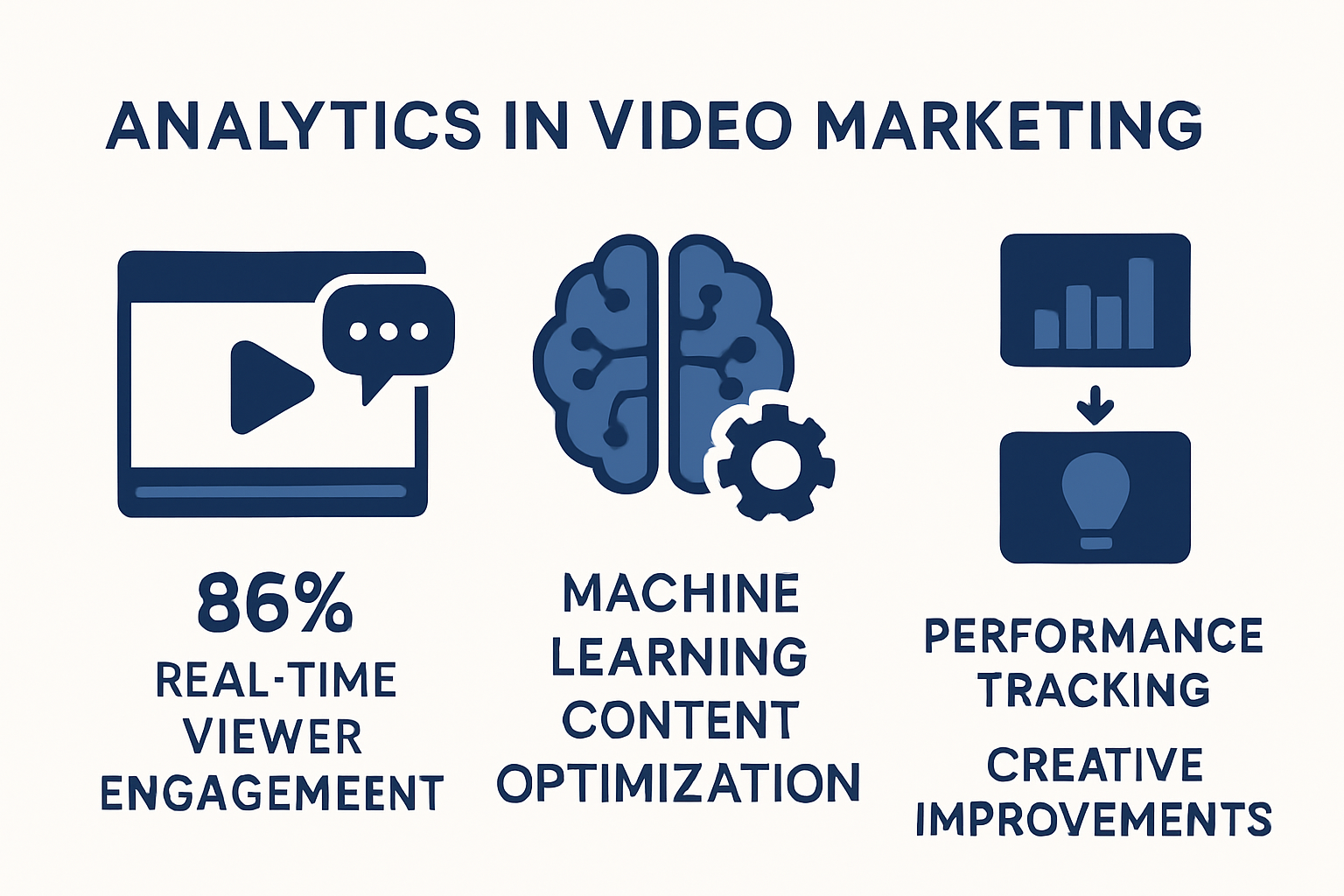The Future of Video Marketing: Key Trends and Strategies
- info1419758
- 6 hours ago
- 10 min read

Video marketing is changing at lightning speed and brands are racing to keep up with the latest trends grabbing attention worldwide. Short videos on platforms like TikTok now soak up billions of views every day and over 90 percent of marketers say video content brings them new customers. Most people think viral clips are about catchy dances or quick laughs. But something unexpected is happening. The biggest wins are going to brands that use AI-powered storytelling and cultural insights to create videos that connect across the globe in ways never seen before.
Table of Contents
Quick Summary
Takeaway | Explanation |
Embrace Short-Form Videos | Short videos capture attention quickly and are perfect for showcasing products or tutorials. |
Leverage AI for Personalization | Use AI to create tailored video content that matches audience behaviors and preferences. |
Utilize Interactive Video Elements | Implement interactive features like shoppable videos to engage viewers actively. |
Focus on Cultural Localization | Adapt video content to reflect local cultures and communication styles for better resonance. |
Invest in Technology for Global Reach | Build a robust digital infrastructure to support efficient, cross-border video marketing initiatives. |
Emerging Video Marketing Trends Worldwide
The future of video marketing is rapidly evolving, driven by technological advancements and changing consumer behaviors. As digital platforms continue to expand, marketers must stay ahead of emerging trends that reshape how brands connect with audiences through visual storytelling.
The Rise of Short-Form Video Content
Short-form video content has exploded in popularity, transforming how brands engage with audiences. Statista’s research reveals a significant shift towards mobile-first video strategies, with platforms like TikTok, Instagram Reels, and YouTube Shorts becoming critical marketing channels. Brands are now creating bite-sized content that captures attention within seconds, recognizing that modern consumers have increasingly shorter attention spans.
The trend goes beyond mere entertainment. Businesses are leveraging short-form videos to showcase products, share quick tutorials, and create authentic connections with their target audience. These micro-videos allow for rapid storytelling, enabling brands to communicate complex messages in just a few seconds. The key is creating content that is not only concise but also compelling and shareable.
Artificial Intelligence and Personalized Video Experiences
Artificial intelligence is revolutionizing video marketing by enabling unprecedented levels of personalization. Marketers are now using AI-driven technologies to analyze viewer preferences, behavior, and engagement patterns to create tailored video content. This approach allows for more targeted and relevant marketing experiences that resonate deeply with individual viewers.
Advanced algorithms can now predict viewer interests, recommend personalized video content, and even help brands create dynamic video variations that adapt to specific audience segments. For instance, an AI system might generate slightly different video versions for different age groups, geographic locations, or personal interests, ensuring maximum engagement and connection.
Emerging Platforms and Interactive Video Strategies
The future of video marketing extends beyond traditional platforms. Connected TV (CTV) advertising is experiencing remarkable growth, providing brands with new opportunities to reach audiences through streaming services. Research indicates that programmatic video ad buying is becoming increasingly sophisticated, allowing for more precise targeting and more efficient marketing spend.
Interactive video technologies are also gaining momentum. Brands are experimenting with choose-your-own-adventure style content, shoppable videos, and immersive experiences that allow viewers to engage directly with the marketing content. This approach transforms passive viewing into an active, participatory experience.
For more comprehensive insights into creating compelling video content, explore our guide on video production best practices that can help elevate your marketing strategies.
As the digital landscape continues to evolve, successful video marketing will require a combination of creativity, technological understanding, and a deep connection with audience preferences. Brands that can adapt quickly, embrace new technologies, and tell authentic stories will be best positioned to thrive in this dynamic environment.
Impact of New Technology on Video Campaigns
Technology is dramatically reshaping video marketing campaigns, introducing innovative tools and approaches that fundamentally transform how brands create, distribute, and measure visual content. The rapid evolution of digital technologies is providing marketers with unprecedented capabilities to engage audiences more effectively and efficiently.
Advanced Data Analytics and Performance Tracking
Research from Harvard Business School highlights the critical role of data-driven technologies in modern marketing strategies. Advanced analytics platforms now enable marketers to track granular performance metrics beyond traditional views and clicks. These sophisticated tools provide real-time insights into viewer engagement, emotional responses, and behavioral patterns.
Modern video campaign technologies can now analyze viewer interactions with frame-by-frame precision. Machine learning algorithms can detect subtle viewer reactions, such as moments of peak interest, potential drop-off points, and emotional resonance. This depth of understanding allows brands to refine their content strategy continuously, creating more targeted and compelling video experiences.

Immersive Technologies and Enhanced Viewer Experience
Cutting-edge technologies like augmented reality (AR) and virtual reality (VR) are revolutionizing video marketing by creating immersive, interactive experiences. Brands are no longer confined to passive video consumption but can now develop engaging, three-dimensional storytelling environments that allow viewers to explore and interact with content.
For instance, fashion brands can now create virtual fitting rooms, while automotive companies can offer virtual test drive experiences. These technologies blur the lines between traditional video marketing and interactive consumer experiences. The result is a more engaging, memorable interaction that goes far beyond conventional advertising approaches.
Automation and Personalized Content Creation
Artificial intelligence and machine learning are transforming content creation processes. Automated video generation tools can now produce personalized video content at scale, adapting messaging, visuals, and tone to specific audience segments. These technologies analyze viewer data to create dynamically tailored video experiences that feel uniquely crafted for individual viewers.
Additionally, AI-powered editing tools can streamline post-production processes, enabling faster content creation and more efficient marketing workflows. Learn more about implementing creative video production techniques to maximize these technological advancements.
As technology continues to evolve, successful video marketing will require a delicate balance between technological innovation and authentic storytelling. Brands that can effectively leverage these advanced tools while maintaining genuine, human-centered narratives will be best positioned to capture audience attention and drive meaningful engagement in an increasingly complex digital landscape.
To help you compare how new technologies are transforming video marketing, here’s a table summarizing key technological innovations and their unique impacts on video campaigns:
Technology/Approach | Main Benefit | Example Applications |
Advanced Data Analytics | In-depth performance insights | Precise viewer tracking, identifying emotional resonance |
Immersive Technologies (AR/VR) | Enhanced, interactive experiences | Virtual fitting rooms, virtual test drives |
Automation & AI Content Creation | Faster, tailored video production | Automated editing, dynamic audience segmentation |
Interactive Video Elements | Increased viewer engagement | Shoppable videos, choose-your-own-adventure content |
Creative Storytelling and Global Audience Engagement
In the evolving world of video marketing, creative storytelling has emerged as a powerful strategy for connecting with global audiences. Brands are moving beyond traditional advertising approaches, focusing on narrative techniques that transcend cultural boundaries and create meaningful emotional connections.
Narrative Complexity and Cultural Resonance
Research from Google reveals that successful global content creators are now leveraging multi-language strategies to expand their reach. This approach goes beyond simple translation, requiring deep understanding of cultural nuances and storytelling techniques that resonate across different regions.
The key to effective global storytelling lies in creating narratives that maintain universal emotional appeal while respecting cultural diversity. Brands are developing video content that explores shared human experiences, using storytelling techniques that can connect with viewers regardless of their geographical or cultural background. This means crafting narratives that touch on fundamental human emotions like hope, love, challenge, and triumph.
AI-Driven Personalized Storytelling
Emerging research in generative AI is transforming how brands approach storytelling. Advanced AI technologies can now help create dynamically personalized narratives that adapt to individual viewer preferences, cultural contexts, and emotional responses. These technologies analyze viewer data to craft stories that feel uniquely tailored to each audience segment.
For instance, an AI system might adjust a brand story’s tone, characters, or narrative arc based on the viewer’s cultural background, age group, or previous engagement patterns. This level of personalization allows for incredibly nuanced storytelling that can create deeper, more meaningful connections with global audiences.
Emotional Engagement and Brand Narrative
Research on digital engagement highlights the critical role of emotional storytelling in building brand loyalty. Videos that tell compelling stories can transform passive viewers into engaged brand advocates, creating lasting connections that go far beyond traditional marketing approaches.
Successful global storytelling requires a delicate balance between universal themes and cultural specificity. Brands must develop narratives that feel authentic, respectful, and genuinely engaging. Explore our guide on creative video production techniques to understand how to craft compelling global narratives.
As the digital world becomes increasingly interconnected, the brands that master the art of global storytelling will be those that can create genuine, emotionally resonant content. This means moving beyond cultural stereotypes, embracing complexity, and recognizing the shared human experiences that unite audiences across different regions and backgrounds.

Actionable Strategies for International Brands
In the complex landscape of global video marketing, international brands must develop sophisticated strategies that transcend traditional one-size-fits-all approaches. Success requires a nuanced understanding of diverse market dynamics, cultural sensitivities, and technological capabilities that enable precise, targeted communication.
Localization and Cultural Intelligence
Research from Think with Google emphasizes the critical importance of deep cultural localization in video marketing. Brands can no longer rely on generic, translated content. Instead, they must create video assets that are genuinely adaptive, reflecting local cultural nuances, communication styles, and emotional resonances.
Effective localization goes beyond language translation. It involves understanding local humor, visual aesthetic preferences, social norms, and communication expectations. Successful international brands invest in local creative talent who can provide authentic insights and help craft videos that feel native to each specific market. This might mean developing entirely different narrative approaches or visual styles for different regions, ensuring that the core brand message remains consistent while its expression remains culturally relevant.
Below is a table outlining critical aspects of effective cultural localization in international video marketing, based on points discussed in the article:
Aspect of Localization | Description | Why It Matters |
Language Adaptation | Translating and adapting scripts for local audiences | Ensures clear message delivery |
Visual Style Preferences | Aligning video imagery with local tastes | Increases authenticity, resonance |
Humor & Social Norms | Reflecting region-specific communication and values | Prevents misinterpretation, boosts relatability |
Local Creative Talent | Involving native creators in video production | Brings cultural insight, builds trust |
Emotional Resonance | Crafting stories around shared human experiences | Connects deeply with diverse markets |
Strategic Content Adaptation and Analytics
Modern international brands are leveraging advanced analytics and flexible content strategies to optimize their video marketing efforts. By using sophisticated data analysis tools, brands can track performance across different markets, understanding subtle variations in audience engagement, content preferences, and viewing behaviors.
This data-driven approach allows for rapid, iterative content optimization. Brands can quickly identify which video elements resonate in specific markets and adjust their creative assets accordingly. Machine learning algorithms can help predict content performance, suggesting modifications that enhance cultural relevance and viewer engagement. The goal is to create a dynamic, responsive video marketing ecosystem that can adapt in real-time to diverse global audience preferences.
Technological Infrastructure and Global Collaboration
Building a robust technological infrastructure is crucial for international video marketing success. Brands must invest in cloud-based collaboration tools, advanced content management systems, and flexible production workflows that enable seamless cross-border content creation. This involves creating standardized yet adaptable creative templates, establishing clear communication protocols, and developing scalable production processes.
Learn more about implementing creative video production techniques that can help international brands develop more effective global marketing strategies. The most successful brands will be those that can balance global brand consistency with local market adaptability, creating video content that feels simultaneously universal and intimately personal.
As global markets become increasingly interconnected, the brands that master the art of nuanced, culturally intelligent video marketing will be best positioned to build meaningful connections with diverse audiences. This requires a holistic approach that combines technological innovation, creative flexibility, and deep cultural understanding.
Frequently Asked Questions
What are the key trends shaping the future of video marketing?
The key trends include the rise of short-form video content, the use of artificial intelligence for personalized experiences, the adoption of interactive video strategies, and the integration of immersive technologies like AR and VR.
How can brands leverage short-form video content to engage audiences?
Brands can create concise, impactful videos that quickly showcase products, share tutorials, or tell compelling stories, capitalizing on platforms like TikTok and Instagram Reels to connect with viewers effectively.
What role does artificial intelligence play in personalized video marketing?
Artificial intelligence enables marketers to analyze viewer preferences and behaviors, allowing for the creation of tailored video content that resonates with individual segments of the audience, enhancing engagement and relevance.
Why is cultural localization important in global video marketing?
Cultural localization ensures that video content is relevant and relatable to diverse audiences by adapting messaging, visuals, and storytelling techniques to align with local cultures, norms, and emotional connections.
Turn Global Video Marketing Trends Into Seamless Swiss Productions
Are you inspired by emerging video marketing trends and personalized storytelling but worried about the real-world hurdles of shooting internationally? Many marketers and filmmakers struggle with permits, local logistics, and building an expert crew—especially when trying to create authentic, culturally resonant content across borders. The latest marketing innovations spotlight the need for speedy, high-quality production and flawless localization. But these goals quickly get lost if your team is held back by logistical headaches or unreliable support on the ground.

Partner with Video Production Switzerland to solve these challenges today. With over 20 years of experience, we handle every step of your production in Switzerland—from permits and location scouting to trusted crew and seamless transportation. See how our process removes the guesswork and stress. Ready for smooth, on-time shoots that let you focus on creativity, not coordination? Book your free consultation now and bring your next big video strategy to life.
Recommended
Sustainable Video Production: Best Practices for Industry Impact
Top Video Marketing Strategies for Business Growth 2025|BM
Marketing Trends 2025: Erfolgsstrategien für Marketer & E-Commerce

Comments